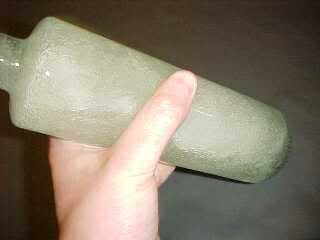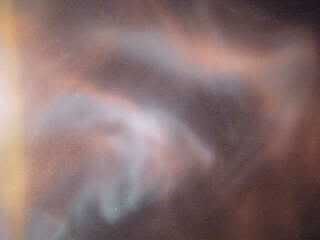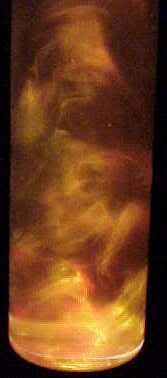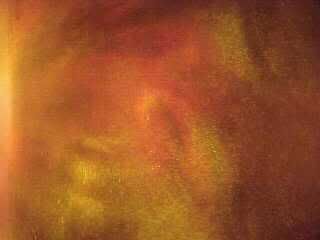Have you ever noticed the strange pearl effect that is seen in some liquid soaps? The chances are it's caused by Glycol Stearate or Glycol Distearate which gives a strange optical effect in liquid when it is disturbed by turbulence.
This design was inspired in January 2003 when I was washing my hands after a long day derigging Glasgows Christmas lights. I squirted some liquid soap onto my hands, and observed the way the pearl effect changed when I ran a finger through the puddle of soap. Wondering if it would work if the soap was suspended in water, I added some water to the soap in my hand and stirred it up. The resultant swirling was inspiring, and I went and bought a tub of the most pearly liquid soap I could find on my way home from work.
When I got home, I got an empty lava lamp bottle and filled it with water and a few squirts of soap, then placed it on a lava lamp base to see if the heat from the lamp would cause enough water turbulence to create the pearling effect. It did so in style! so here's the plans for a super easy lighting effect that looks superb.
This design was inspired in January 2003 when I was washing my hands after a long day derigging Glasgows Christmas lights. I squirted some liquid soap onto my hands, and observed the way the pearl effect changed when I ran a finger through the puddle of soap. Wondering if it would work if the soap was suspended in water, I added some water to the soap in my hand and stirred it up. The resultant swirling was inspiring, and I went and bought a tub of the most pearly liquid soap I could find on my way home from work.
When I got home, I got an empty lava lamp bottle and filled it with water and a few squirts of soap, then placed it on a lava lamp base to see if the heat from the lamp would cause enough water turbulence to create the pearling effect. It did so in style! so here's the plans for a super easy lighting effect that looks superb.

You will require a bottle and some pearlised soap.
I chose this bottle since it happens to sit perfectly into a standard Mathmos lava lamp base.

The soap should have either Glycol Stearate or Glycol Distearate in the list of ingredients, and you should look about for the most pearly looking stuff you can find. (tilt the bottles upside down to see the pearl trail left by the air inside the bottle)
As you can see in the picture above, any disturbance in the liquid causes the effect to appear.

Remove the label from the bottle and fill it with water, then put in as many squirts of soap as you like.
The effect varies from the slightest wisp of cloud, through to a dense translucent effect according to the amount of soap used. Five squirts is a good starting point.

Shake the bottle to mix the water and soap, then top up with water if desired, leaving a small air gap at the top for fluid expansion.

Stick it on the lamp base, turn it on, and wait for the effect to start in about a minute as the heat starts moving the water.
A 40W lamp produces a fast turbulence, but a lower wattage lamp like 15 or 25W gives a slower more dreamy effect. The lower wattage lamps are preferred, since overheating the liquid causes emulsification and stops the effect working.
It's important to use a CLEAR lamp for the best effect!

The clouds just seem to form and disappear in the water in a way that is hard to show in a flat picture.

You can add colour by either using a coloured lamp, a drop of food colouring in the water or theatre lighting gel between a low wattage lamp and the bottle.
In the picture above I have Selotaped two colours of gel together (out of a gel swatch book), and used the bottle as a template to get a two colour gel.

With the gel cut to size, it is placed in position over the 15W lamp, making sure that it does not rest directly on the lamp.

The result is two-tone clouds with different clouds picking out different colours.

Here's another narrower lamp with a red and yellow gel.

A close up of the swirling clouds shows what appears to be the effect of thousands of tiny lenses swirling in the liquid.
If you don't have an existing lava lamp base, then a simple fix is to use a standard MR16 downlighter. These are the cheap frames that take a 12V 20W dichroic spotlight.
If the spotlight frame is mounted face up in a box or even directly into a shelf, then a flat bottomed bottle can be sat directly on the frame over the face of the lamp.
Using a lamp with a coloured dichroic front glass gives a very good effect.
This effect is so cheap and easy to achieve that it can be scaled up easily. With a higher wattage lamp you can use very large glass containers, and it could even be used in a flat glass tank with a row of spotlights underneath.
If the spotlight frame is mounted face up in a box or even directly into a shelf, then a flat bottomed bottle can be sat directly on the frame over the face of the lamp.
Using a lamp with a coloured dichroic front glass gives a very good effect.
This effect is so cheap and easy to achieve that it can be scaled up easily. With a higher wattage lamp you can use very large glass containers, and it could even be used in a flat glass tank with a row of spotlights underneath.
http://www.bigclive.com/cloud.htm

0 comments:
Post a Comment